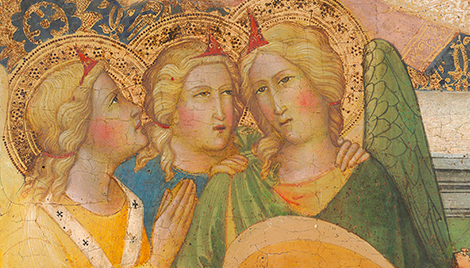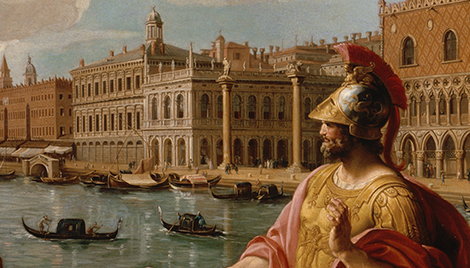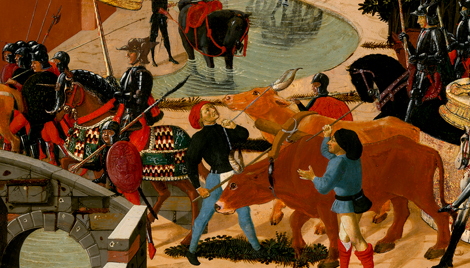Kress Grantee Spotlight: Paul Jaskot, Duke University
Paul B. Jaskot is Co-Director of the Duke Digital Art History & Visual Culture Lab and Professor of Art History at Duke University. He specializes in the history of modern German architecture and art, with a particular interest in the political history of architecture before, during, and after the Nazi era. He has also published on Holocaust Studies topics more broadly, modern architecture including the history of Chicago architecture, and methodological essays on Marxist art history. He has authored or edited several monographs and anthologies, including The Nazi Perpetrator: Postwar German Art and the Politics of the Right (University of Minnesota Press, 2012) and, as co-editor, New Approaches to an Integrated History of the Holocaust: Social History, Representation, Theory (Evanston: Northwestern University Press, 2018). From 2008-2010, he was the President of the College Art Association (CAA). With CAA, he has also participated in various task forces promoting the support of and guidelines for Digital Art History and its professional evaluation. He continues to be active with CAA and with the promotion of Digital Art History initiatives nationally.
Read on to hear more about Paul's research and work at Duke's Digital Art History & Visual Culture Lab, in conversation with Shea Spiller from the Kress Foundation.
—
Shea Spiller: To start, what is your current role at Duke University?
Paul Jaskot: I am Department Chair and Director of the Digital Art History & Visual Culture (DAHVC) Research Lab (formerly the Wired Lab) and Professor in Art History. We have a very active lab culture here—there are five labs in our program.
SS: And what exactly is the DAHVC lab?
PJ: It’s this kind of crazy agglomeration of many different people and many, many, many different interests. So, what do we do? We really are about cultural objects, scale, and space—those are the three terms that I would associate most closely with what we do and the kinds of art historical problems we address. And we're thinking about exploring these questions of object, scale, and space for art history in terms of the digital environment.
I arrived at Duke in 2017, and it’s quite amazing how vibrant the community is. Every Friday afternoon, you have faculty, staff, and students, both graduates and undergraduates, all working together on collaborative projects that involve some aspect of the digital exploration of these themes of objects, spaces, and scale. The collaborative nature of this work is crucial for us.
SS: Can you give an example of what that exploration looks like? I’m sure it varies, but perhaps you can give an example of a recent project that you feel is representative of the kind of work you’re doing.
PJ: I’m doing two projects here, one is Digital Krakow which examines Krakow under the Nazi occupation, and the second one is Digital Public buildings in North Carolina.
The Digital Public Buildings in North Carolina project was initially meant to help me and the students familiarize ourselves with North Carolina as a large scale building environment. There are studies of individual buildings and guidebooks and other wonderful resources to look at individual buildings, but thinking the state systemically as a construction zone, as a zone of design and reception, that was something new and it's harder to do if you're just one person or one project.
Over time we've been building databases of public architecture in North Carolina. For example, we just finished up a database of courthouses and jails at the county level. This forces us to look beyond the urban focus, or bias, of art history and encourages us to look beyond the individual object, even though individual objects are still very crucial. This allows us to explore larger questions through digital means and through scaler means. For example, investigating the role of brick in the building economy.
A Sanborn map annotated to show the locations where Black people worked and lived in early-twentieth-century Raleigh. Map Credit: Paloma Rodney
PJ: That same kind of interest in thinking systemically is also something we're taking over into the Digital Krakow project, which is part of my own research on the Nazi period and particularly the Holocaust. I came to this with an interest in construction and forced labor, so a rather difficult project, but one that I think is quite important in terms of the ethics of thinking about how architecture is related to moments of oppression.
The project is always expanding and, while we might say we started with an object which in this case was an urban site, it’s constantly evolving as other students and colleagues have gotten involved and have pushed us in different ways. Right now, we're thinking about building the digital environment as itself part of the research. That is, we're not going to build a finished model that necessarily looks really polished and is ready to put in a museum, but we’re learning through building the model and exploring different kinds of digital methods. For example, analyzing testimony through text mining, or building a 3D model to think about view sheds and what could be seen at what time. By using these digital explorations, we're learning more about the sources and the buildings themselves.
Ironically, I think this modern new method of digital is leading us back to very old art historical questions that rest on understanding our sources and objects better.
Model of Krakow’s Wawel Castle highlighting Nazi-era construction. Image Credit: Alan Carrillo
SS: It’s so interesting to hear how these very digital tools ultimately enable you to better understand existing documents and objects. It seems like the digital allows you to zoom out and see the bigger picture of the topic you’re working on, enabling you to identify paths of inquiry you may not have seen otherwise.
PJ: Absolutely, it's really about revealing new questions. I would say that most of our digital work is not about coming to definitive conclusions, but it's about opening up in new ways. In that regard, digital work is more like archival work in revealing the possibilities of an archive.
SS: And when you’re doing that kind of work, what are the sort of tools that you're using? I understand in an abstract sense what the work is, but when you're actually coming to the lab, what is it that you’re doing?
PJ: It can start as basic as an Excel spreadsheet. The first courthouse database we did, which followed up on a prison database we had done previously, was an Excel spreadsheet. It’s essentially about organizing information. Again, think archivally: you need to take notes and put things in different fields.
One thing that’s so exciting about this process is how deeply humanist it is. When you begin categorizing humanistic information—which means it's ambiguous, it's contradictory, it's not complete—you have to make decisions and you have to interpret from a point of knowledge. This is where the teaching comes in.
Some of the things we think about are: How are we structuring our data? What is the database we want to structure? Are we capturing experience? Are we capturing labor, are we capturing policy? Are we capturing design, are we capturing materials? These are all questions that we have to think about as part of the research question, which then helps us think about how we're structuring data.
To summarize, the basic tool we use is a database, but the questions are about how we structure that data and then how we visualize that as part of this exploratory environment. I like to think of these digital structures as methods rather than tools, because like any method it's about the intellectual question of why you're using a specific method for a particular kind of critical analysis.
SS: I really like the framing of digital art history and digital humanities as a method of working rather than as tools. As with any methodology, it's just opening you up to more questions and different ways of asking those questions.
SS: At Duke, you offer a degree in digital art history studies. What are the differences between a digital art history studies degree program and a more traditional art history degree?
PJ: That's a great question and the answer is twofold. On the one hand, of course, there are many digital humanities master’s and PhD degree programs at places like Virginia, UCLA, and Columbia, so this isn’t something new.
However, at Duke, the distinction is that we've embedded digital humanities in the art history program, it’s not separate. Students come here to do art history as digital humanities, so it's truly a master’s in digital art history, not a master’s in digital humanities with an art history focus.
In some ways this distinction makes no difference, but in other ways it makes a huge difference because what it means is that, from the undergraduate to PhD levels of education, we're thinking about what is at that digital core. We center the art historical question in a way that is unusual compared to other programs, and that allows our students to really think about the digital as essential to art history. But it’s important that they're not digital enthusiasts in an uncritical way.
SS: I know we already talked about two of your projects, but are there any other recent projects at the lab that you'd like to share?
PJ: There are so many good ones, but I would be remiss if I didn't mention a few. One is the Book of Fortresses, which is led by Ed Triplett. Ed is using Houdini, a gaming software, which allows him to create a very flexible 3D environment. It's some of the most creative mapping I've ever seen in my life. The Fortress is a 15thcentury book that mapped the border of Portugal for the first time and did so by mapping fortresses. It's this profound project that asks: How can you use mapping and modeling software to explore an extraordinary primary source like this incredible 15th-century document?
We also have Mark Olson who is working on Art of the Americas, which is a kind of museum environment extension and using 3D modeling and digital reconstruction to think about the art of pre- contact America.
Then we have Sheila Dillon’s work on the Agora of Athens and mapping those archaeological finds and thinking about them changing over time. She's thinking about the archaeological work of the 1930s as much as she's thinking about it in the ancient period and it's really proven to be quite rich.
It just goes on and on, but space, object, and scale are always at the core of all our work.
SS: Where do you see real opportunities for innovation and growth in the field right now? And what makes you most excited to be working in this field now and into the future?
PJ: The opportunities are many, but I've always thought that one of the big advantages of the digital is the way that it forms community. It requires an ecosystem and, like any ecosystem, it has to be managed, sustained, and cared for, and it requires many people working together.
There’s a lot more work for the digital to do in that realm that is both optimistic and critical. Optimistic in the sense that I hope people can realize this helps them and can bring them deeper into their research and interests. But there’s also the element of the kinds of critical questions that can be answered here. So, I’m optimistic, but it’s the optimism of what we might call the struggle that's always going to be at the heart of art history. There, the digital questions are in many ways very much ones that address systems, economics, and materials. At the center of it all is a very old historical question, one that asks you to think at the macro scale as much as the micro.
SS: The combination of optimism and critical looking at the same time seems key.
PJ: And again, it's not new, right? This is the feminist challenge of the 70s and the 80s, the critical race theory challenge of the 90s and the aughts, or even the Marxist challenge of the 60s. It’s not new to be struggling over what is at the center of our field. These are all questions and debates, and this is just one more site that we have to debate over what really what really matters.
SS: That’s a great note to end on. Thank you so much for taking the time to speak with me.
PJ: I also just want to say how grateful I am to Kress. The Foundation has seeded us all along the way and it’s been really crucial. They’ve helped to build that ecosystem that we need.
—



